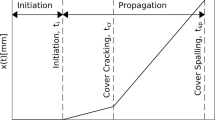Abstract
Throughout the world, buildings are reaching the end of their design life and develop new pathologies that decrease their structural capacity. Usually the ageing process is neglected in seismic design or seismic risk assessment but may become important for older structures, especially, if they are intended to be in service even after they exceed their design life. Thus, a simplified methodology for seismic performance evaluation with consideration of performance degradation over time is presented, based on an extension of the SAC/FEMA probabilistic framework for estimating mean annual frequencies of limit state exceedance. This is applied to an example of an older three-storey asymmetric reinforced concrete building, in which corrosion has just started to propagate. The seismic performance of the structure is assessed at several successive times and the instantaneous and overall seismic risk is estimated for the near collapse limit state. The structural capacity in terms of the maximum base shear and the maximum roof displacement is shown to decrease over time. Consequently, the time-averaged mean annual frequency of violating the near-collapse limit state increases for the corroded building by about 10% in comparison to the typical case where corrosion is neglected. However, it can be magnified by almost 40% if the near-collapse limit state is related to a brittle shear failure, since corrosion significantly affects transverse reinforcement, raising important questions on the seismic safety of the existing building stock.
Similar content being viewed by others
References
Berto L, Vitaliani R, Saetta A, Simioni P (2009) Seismic assessment of existing RC structures affected by degradation phenomena. Struct Saf 31: 284–297
CEN (2004) Eurocode 8: design of structures for earthquake resistance. Part 1: general rules, seismic actions and rules for buildings, EN 1998-1. European committee for standardisation, Brussels, December 2004
CEN (2005) Eurocode 8: design of structures for earthquake resistance. Part 3: strengthening and repair of buildings. EN 1998-3, European committee for standardisation, Brussels, March 2005
Choe D, Gardoni P, Rosowsky D, Haukaas T (2009) Seismic fragility estimates for reinforced concrete bridges subject to corrosion. Struct Saf 31: 275–283
Cornell CA, Jalayer F, Hamburger RO, Foutch DA (2002) Probabilistic basis for 2000 SAC federal emergency management agency steel moment frame guidelines. J Struct Eng 128: 526–533
Dolsek M (2009) Incremental dynamic analysis with consideration of modeling uncertainties. Earthq Eng Struct Dyn 38(6): 805–825
Dolsek M (2010) Development of computing environment for the seismic performance assessment of reinforced concrete frames by using simplified nonlinear models. Bull Earth Eng 8(6): 1309–1329
Dolšek M, Fajfar P (2007) Simplified probabilistic seismic performance assessment of plan-asymmetric buildings. Earthq Eng Struct Dyn 36: 2021–2041
Dolšek M, Fajfar P (2008) The effect of masonry infills on the seismic response of a four storey reinforced concrete frame–a probabilistic assessment. Eng Struct 30: 3186–3192
Estes AC, Frangopol DM (2001) Bridge lifetime system reliability under multiple limit states. J Bridge Eng 6(6): 523–528
Fajfar P (2000) A nonlinear analysis method for performance-based seismic design. Earthq Spec 16(3): 573–592
Fajfar P, Dolšek M, Marušić D, Stratan A (2006) Pre- and post-test mathematical modeling of a plan-asymmetric reinforced concrete frame buildings. Earthq Eng Struct Dyn 35: 1359–1379
FEMA 350: (2000) Recommended seismic design criteria for new steel moment frame buildings. SAC joint venture, federal emergency management agency, Washington, DC
FEMA P695: (2009) Quantification of building seismic performance. Prepared by the advanced technology council for the federal emergency management agency, Washington, DC
Kumar R, Gardoni P, Sanchez-Silva M (2009) Effect of cumulative seismic damage and corrosion on the life cycle cost of reifirced concrete bridges. Earthq Eng Struct Dyn 38: 887–905
McKenna F, Fenves GL (2004) Open system for earthquake engineering simulation, Pacific Earthquake Engineering Research Center, Berkeley, California http://opensees.berkeley.edu/
Pantazopoulou SJ, Papoulia KD (2001) Modeling cover-cracking due to reinforcement corrosion in RC structures. J Eng Mech 127(4): 342–351
Peruš I, Poljanšek K, Fajfar P (2006) Flexural deformation capacity of rectangular RC columns determined by the CAE method. Earthq Eng Struct Dyn 35: 1453–1470
Ruiz-Garcia J, Miranda E (2003) Inelastic displacement ratios for evaluation of existing structures. Earthq Eng Struct Dyn 32: 1237–1258
Stewart MG (2009) Mechanical behavior of pitting corrosion of flexural and shear reinforcement and its effect on structural reliability of corroding RC beams. Struct Saf 31: 19–30
Torres MA, Ruiz SE (2007) Structural reliability evaluation considering capacity degradation over time. Eng Struct 29: 2183–2192
Val DV, Stewart MG, Melchers RE (1998) Effect of reinforcement corrosion on reliability of highway bridges. Eng Struct 20: 1010–1019
Val DV, Stewart MG (2009) Reliability assessment of ageing reinforced concrete structures – current situation and future challenges. Struct Eng Inter 19(9): 211–219
Vamvatsikos D, Cornell CA (2002) Incremental dynamic analysis. Earthq Eng Struct Dyn 31: 491–514
Vamvatsikos D, Cornell CA (2006) Direct estimation of the seismic demand and capacity of oscillators with multi-linear static pushovers through incremental dynamic analysis. Earthq Eng Struct Dyn 35(9): 1097–1117
Vamvatsikos D, Dolšek M. (2010) Equivalent constant rates for performance-based seismic assessment of ageing structures. Struct Saf 33(1): 8–18
Yun S-Y, Hamburger RO, Cornell CA, Foutch DA (2002) Seismic performance evaluation for steel moment frames. J Struct Eng ASCE 128(4): 534–545
Author information
Authors and Affiliations
Corresponding author
Additional information
This article is based on short paper presented at the COMPDYN 2009 Conference (Rhodes, Greece).
Rights and permissions
About this article
Cite this article
Celarec, D., Vamvatsikos, D. & Dolšek, M. Simplified estimation of seismic risk for reinforced concrete buildings with consideration of corrosion over time. Bull Earthquake Eng 9, 1137–1155 (2011). https://doi.org/10.1007/s10518-010-9241-3
Received:
Accepted:
Published:
Issue Date:
DOI: https://doi.org/10.1007/s10518-010-9241-3




